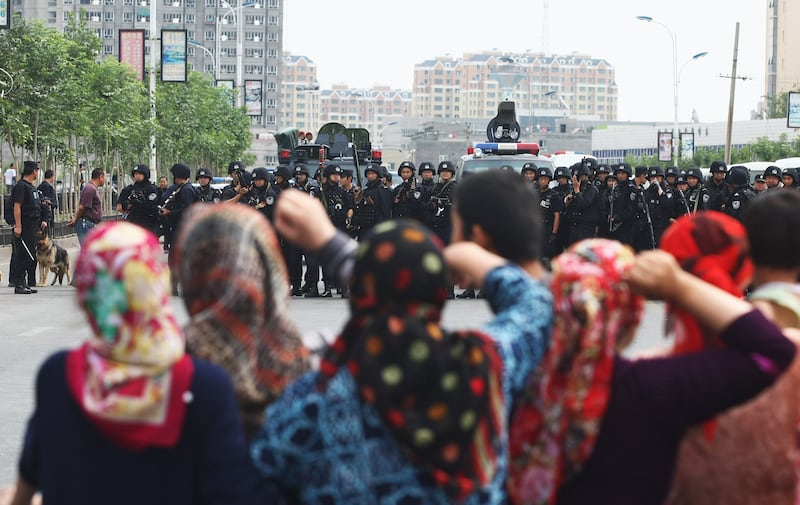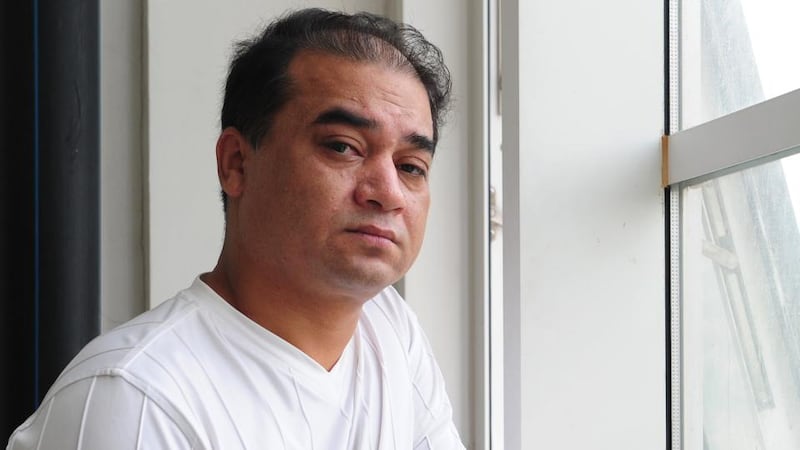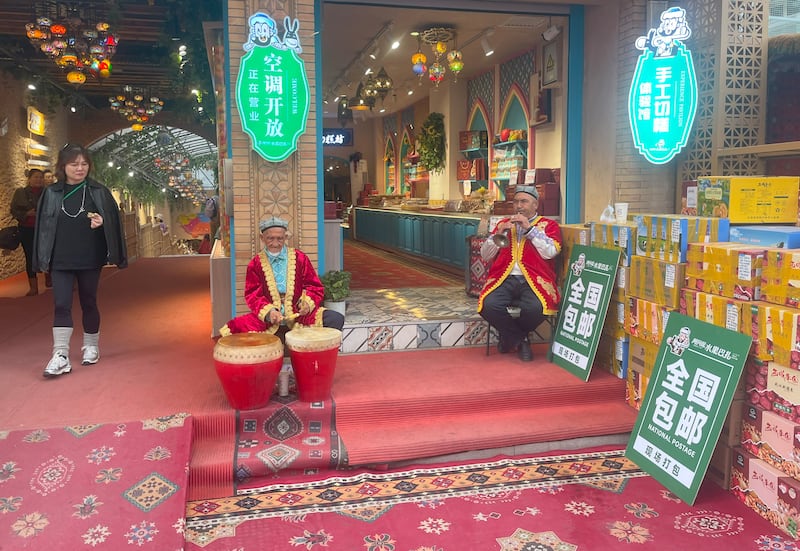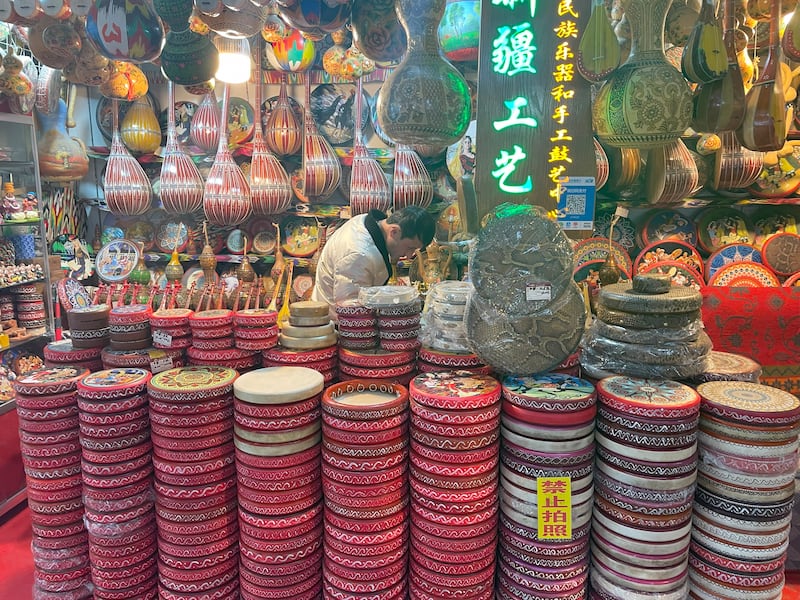It was late in the afternoon and the Guanyu Pavilion would soon be closing, but the little observation deck was still crowded and fresh visitors were arriving – many of them out of breath. Most had taken a shuttle bus up the mountain before climbing more than 1,000 steps, although some came on horseback and a handful made the entire ascent on foot.
From here, they had a spectacular view of the blue-green, meandering Kanas Lake 600m below, framed by hills covered in larch and mountain ash, their leaves yellowing in the late autumn sun. Most posed for selfies against the railings with their backs to the lake, making images to show friends that they had been to what has become China’s most fashionable destination in 2024.
In western Europe and the United States, Xinjiang is seen as China’s pariah province where Beijing has been accused of committing crimes against humanity in its treatment of the Uyghur people and other Muslim minorities. Both the US Congress and the European Parliament have introduced legislation targeting products allegedly made in Xinjiang using forced labour, and MEPs on Thursday adopted a resolution demanding the release of unjustly imprisoned Uyghurs.
Long seen in China as a paradise of unspoilt natural beauty, Xinjiang is experiencing a boom in tourism driven by a television series that became the biggest hit of the summer. Set in the Altay district near Kanas Lake and filmed on location nearby, To the Wonder has inspired hundreds of thousands to make the journey to this part of northern Xinjiang, close to the borders of Kazakhstan, Russia and Mongolia.
READ MORE
Based on My Altay, a collection of essays by Li Juan, To the Wonder tells the story of Li Wenxiu, a Han Chinese girl from Altay who goes to Xinjiang’s capital Urumqi where she hopes to become a writer. But a series of setbacks at work in a hotel drive her home to work in her mother’s shop and into the arms of a local Kazakh boy called Bata.
The lead roles are played by Zhou Yiran and Yu Shi, two of China’s most popular young actors, and the eight-episode series caught a mood among young Chinese viewers with its story of a woman rejecting the rat race in favour of a simpler life. In its portrayal of a clash between tradition and modernity, it also won praise for the respect it showed for the traditions of this majority Muslim, formerly nomadic community.
But it is the beauty of the landscape that draws most visitors to Kanas, where private cars are banned and the number of visitors who can access the district by shuttle bus is limited to 35,000 a day. Most visitors stay in small hotels made up of single-storey log cabins, spending the day hiking or trekking on horseback and eating lamb grilled on skewers at roadside stalls.


“We were attracted by the scenery that we saw in the TV series, so we decided to come here for a trip,” said a young man from Shanghai who was visiting Kanas with his wife and another couple from Beijing during the weeklong holiday around China’s national day.
“Kanas is very popular for the Golden Week holiday. We didn’t get tickets for the bus to the Guanyu Pavilion so we tried to climb up the mountain yesterday along the horse riding tracks. Halfway up, we found it was too hard for us, so we gave up.”
A trip to Altay makes for an expensive holiday, with flights into the tiny airport at Kanas few and costly and the log cabins going for the price of a room in a luxury hotel in Shanghai or Beijing. Rising prices are affecting local people too, and a woman who ran one of the hotels said her daughter who is in college in Sichuan didn’t come home this summer.
“I told her not to come back to Kanas during the vacation because the flight ticket was so expensive, it cost almost 10,000 yuan (€1,300). I gave her some money to stay in Sichuan for the summer instead,” she said.
The Xinjiang Uyghur Autonomous Region – which is not strictly a province – is China’s biggest region, covering one sixth of its territory in an area five times the size of Germany. Although rich in resources such as coal, gas, oil, lithium and zinc and a major producer of cotton, Xinjiang is one of China’s poorest regions.
It shares borders with India, Pakistan, Afghanistan, Kazakhstan, Kyrgyzstan, Tajikistan, Mongolia and Russia, a fact that has long made it a focus of anxiety in Beijing. About 45 per cent of the population are Uyghurs, 42 per cent are Han (the ethnic group 90 per cent of Chinese people belong to) and most of the rest are Hui, Kazakh, Kyrgyz, Mongol and Tajik.
Uyghurs briefly declared an East Turkestan Republic in November 1933 and again from 1944 to 1949, but Xinjiang was brought under Communist control with the foundation of the People’s Republic of China that year. Migration from other parts of China saw the Uyghur share of Xinjiang’s population fall from 75 per cent to 45 per cent, while the proportion of Han Chinese rose.
On July 5th, 2009, a protest in Urumqi against the killing of two Uyghur workers in a factory in southeast China turned violent and led to the deaths of 197 people, most of them Han Chinese. In the days that followed, Han Chinese mobs attacked Uyghurs with sticks and metal bars and the following weeks saw further deadly clashes.

Uyghur separatists killed 31 people in a bomb attack on a crowded market in Urumqi in 2012 and suicide bombers went on a stabbing rampage at a railway station during a visit to the city by Xi Jinping in 2014. At the same time, there were reports that Uyghur men had become fighters in armed Islamist groups in Afghanistan and Syria.
In May 2014 Beijing launched what it called a Strike Hard campaign against terrorist threats, linking the violent attacks to religious extremism and Uyghur separatism. By 2019, the government was claiming that it had destroyed almost 1,600 violent and terrorist gangs, arrested nearly 13,000 terrorists and punished more than 30,000 people for illegal religious activities.
Chinese officials privately compare the Strike Hard campaign to Prevent, Britain’s programme to stop people becoming terrorists, which has itself been criticised for stigmatising Muslims. But the programme in Xinjiang went much further than anything seen in Britain, with severe consequences for those judged to be under the influence of extremism.
Regulations identified signs of extremism including “young and middle-aged men with a big beard” and “suddenly quitting drinking and smoking and not interacting with others who do drink and smoke”. Individuals responsible for minor acts of extremism could be sent to Vocational Education and Training Centres for “deradicalisation and re-education” instead of to prison for punishment.
[ China defends Xinjiang camps as details of programme emergeOpens in new window ]
The Chinese government claimed that the centres were “schools by nature” and not designed to “limit or circumscribe the freedom of the person”. But the centres were residential and people were referred to them by a court or public security officials rather than going voluntarily and they could not leave until the authorities told them their stay was over.
Beijing said the centres closed in 2019; independent reports by foreign media and academics suggest that the programme has ended after more than a million people were detained there. More recently, the focus of western governments and human rights campaigners has shifted on to allegations of forced labour in Xinjiang.
We were attracted by the scenery that we saw in the TV series, so we decided to come here for a trip. Kanas is very popular for the Golden Week holiday
— Tourist from Shanghai
Some of these allegations concern people formerly detained in Vocational Education and Training Centres working in factories set up nearby or by inmates in prisons. Others focus on programmes of poverty alleviation through labour transfer which see workers moved from rural areas to places where labour is needed.
Tomoya Obokata, the UN’s special rapporteur on contemporary forms of slavery, acknowledged in a 2022 report that the labour transfer programmes offered employment opportunities for ethnic minorities but concluded that there were some incidents of forced labour. Beijing has denied the allegations, saying that China follows a “people-centred” approach in protecting the rights and interests of workers.
The European Parliament this week adopted a resolution urging China to unconditionally release Uyghur economist Ilham Tohti, who is serving a life sentence for separatism charges, and Gulshan Abbas, a retired doctor whose 20-year sentence for terrorism supporters claim is related to the activities of her sister, a human rights campaigner.

At the Grand Bazaar in Urumqi on Monday, the last day of the Golden Week holiday brought out the crowds as musicians and dancers performed on the pedestrian street outside. On the street and at the stalls inside the bazaar, signs were in both Uyghur and Mandarin but most people were speaking Uyghur.
The atmosphere was relaxed, as it was throughout the city, but the security presence is heavier than elsewhere in China with black-clad police in full riot gear patrolling the bazaar. Across the street stood an armoured vehicle with two armed police officers in camouflage holding automatic rifles and there were similar vehicles deployed outside the Xinjiang Museum.
The museum was busy, with the biggest crowd in the hall showing six mummified corpses including the so-called Loulan Beauty said to have been buried in a tomb about an hour away from Urumqi nearly 4,000 years ago. Visitors included a group of mostly elderly German tourists following the detailed commentary of a local guide.


Some of Urumqi’s mosques are closed and one is now home to a coffee shop that is famous on social media throughout China. But many remain open and the most famous, the Shaanxi Grand Mosque, is one of the city’s tourist attractions.
Built during the Qing Dynasty in the late 18th century, the mosque is in the Han Chinese architectural tradition of pavilions with upswept eaves, but it also has western Islamic features with its use of glazed tiles and there is a crescent finial on the roof. Two exhibition halls include displays of information about the mosque, but most of the exhibits are about the relationship between the local Muslim community and the Communist Party.
In one display case are books by Xi Jinping in Uyghur and Mandarin and a panel on one of the walls declares that China has been a multi-religious country since ancient times and that several religions have existed side by side.
“Xinjiang treats all religions fairly and equally, showing no favouritism towards any particular religion and no discrimination against any religion. Xinjiang upholds that citizens are equal before the law and must carry out the duties imposed by the Constitution and other laws, whether they believe in or not believe in any religion,” it said.
“Adapting to local society is essential for the survival and development of any religion. The history of religious development in China proves that only when conducting religious activities in the Chinese context can religions better adapt to Chinese society. For religions to develop healthily, they must align with the socialist society.”
- Sign up for push alerts and have the best news, analysis and comment delivered directly to your phone
- Find The Irish Times on WhatsApp and stay up to date
- Our In The News podcast is now published daily – Find the latest episode here





















